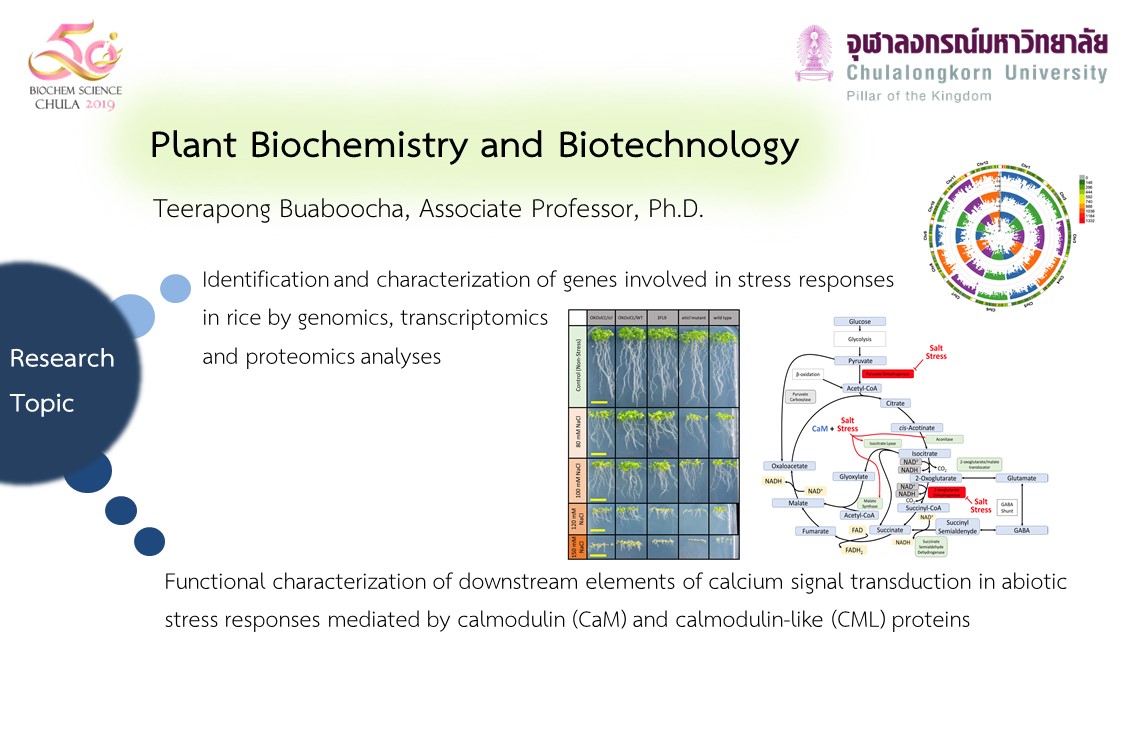
Teerapong Buaboocha, Associate Professor, Ph.D.
B.Sc., Chulalongkorn University
Ph.D., University of Illinois
Office: Room 721.01, Science 10 Building
Phone: 662-218-5436
Fax: 662-218-5418
Email: Teerapong.B@chula.ac.th
Research
 Molecular mechanisms of calcium-mediated stress responses in rice
Molecular mechanisms of calcium-mediated stress responses in rice
I am particularly interested in mechanisms of calcium-mediated responses to stress. Because stress responses are mediated by complex networks of cell signaling, understanding mechanisms of how plants perceive and transmit stress signals and how the functional and regulatory proteins contribute to the tolerance require knowledge of a genome scale. Since the rice genome project has been completed, its genome sequence information can be exploited in this area.
In my lab, we are working on a family of calcium -binding proteins, calmodulin ( CaM ) in rice and trying to determine whether and how they contribute to stress tolerance. We have identified at least 37 CaM and CaM-like (CML) proteins from the rice genome databases. Currently, we focus on the highly conserved CaMs by studying expression of their genes, producing and characterizing the encoded recombinant proteins, identifying their target proteins, producing and examining transgenic rice plants with expression levels of their genes altered.
Our ultimate goal is to understand how stress signals are mediated by calcium-regulated pathways in conjunction with CaM and CML in rice. We will be using proteomic analysis to help identify proteins involved in the calcium/CaM signaling network that mediates stress responses. The knowledge on these proteins not only comprises critical components for understanding stress tolerance, but could also facilitate the effort to genetically improve stress tolerance of crop plants in the future.
Recent Publications
Publications
- Chinpongpanich A, Phean-O-Pas S, Thongchuang M, Qu LJ, Buaboocha T.. C-terminal extension of calmodulin-like 3 protein from Oryza sativa L.: interaction with a high mobility group target protein. Acta Biochim Biophys Sin (Shanghai) 2015, 47(11):880-9.
- Wutipraditkul, N.; Wongwean, P.; Buaboocha, T.. Alleviation of salt-induced oxidative stress in rice seedlings by proline and/or glycinebetaine, Biologia Plantarum 2015, 59 (3), 547-553.
- Sripinyowanich, S.; Chamnanmanoontham, N.; Udomchalothorn, T.; Maneeprasopsuk, S.; Santawee, P.; Buaboocha, T.; Qu, L.-J.; (…); Chadchawan, S.. Overexpression of a partial fragment of the salt-responsive gene OsNUC1 enhances salt adaptation in transgenic Arabidopsis thaliana and rice (Oryza sativa L.) during salt stress. Plant Science 2013 , 213, 67-78.
- Sripinyowanich, S.; Klomsakul, P.; Boonburapong, B.; Bangyeekhun, T.; Asami, T.; Gu, H.; Buaboocha, T.; Chadchawan, S. Exogenous ABA induces salt tolerance in indica rice (Oryza sativa L.): The role of OsP5CS1 and OsP5CR gene expression during salt stress. Environmental and Experimental Botany 2013, 86, 94-105.
- Saeng-ngam S.; Takpirom W.;, Phean-o-pas S.; Chadchawan S.; Buaboocha T. The Role of the OsCam1-1 Salt Stress Sensor in ABA Accumulation and Salt Tolerance in Rice. Bangkok, Thailand. The FAOBMB minisymposium. June 1, 2012 (oral presentation)
- Chinpongpanich A, Limruengroj K, Phean-o-pas S, Limpaseni T, Buaboocha T. Expression analysis of calmodulin and calmodulin-like genes from rice, Oryza sativa L. BMC Research Notes 2012, 5:625
- Sripinyowanich, S.; Klomsakul, P.; Boonburapong, B.; Bangyeekhun, T.; Asami, T.; Gu, H.; Buaboocha, T.; Chadchawan, S. Exogenous ABA induces salt tolerance in indica rice (Oryza sativa L.): The role of OsP5CS1 and OsP5CR gene expression during salt stress. Environmental and Experimental Botany 2013, 86, 94-105.
- Saeng-ngam S.; Takpirom W.; Buaboocha T.; Chadchawan S. The role of the OsCam1-1 salt stress sensor in ABA accumulation and salt tolerance in rice. J. Plant Biol. 2012, 55(3), 198-208.
- Chinpongpanich A, Wutipraditkul N, Thairat S, Buaboocha T. Biophysical characterization of calmodulin and calmodulin-like proteins from rice, Oryza sativa L. Acta Bioch Bioph Sin 2011, 43: 867-876.
- Wutipraditkul N, Boonkomrat S, Buaboocha T. Expression and characterization of catalases from rice, Oryza sativa. Biosci Biotech Bioch 2011, 75(10): 1900-1906.
- Phean-o-pas S, Limpaseni T, Buaboocha T. Structure and expression analysis of the OsCam1-1 calmodulin gene from Oryza sativa L. BMB Reports 2008, 41(11): 771-777
- Boonburapong B, Buaboocha T . Genome-wide identification and analyses of the rice calmodulin and related potential calcium sensor proteins. BMC Plant Biology 2007, 7:4
- Laloknam S, Tanaka K, Buaboocha T , Waditee R, Incharoensakdi A, Hibino T, Tanaka Y, Takabe T. A Halotolerant cyanobacterium Aphanothece halophytica contains betaine transport that is active at alkaline pH under high salinity conditions. Appl Environ Microb 2006, 72(9): 6018-6026
- Waditee R, Buaboocha T, Kato M, Hibino T, Suzuki S, Nakamura T, Takabe T. Carboxyl terminal hydrophilic tail of a NhaP type Na+/H+ antiporter from cyanobacteria is involved in the apparent affinity for Na+ and pH sensitivity. Arch Biochem Biophysics 2006, 450(1): 113-121
- Phean-o-pas S, Punteeranurak P, Buaboocha T. Calcium signaling-mediated and differential induction of calmodulin gene expression by stress in Oryza sativa L. J Biochem Mol Biol 2005, 38(4): 432-439
- Buaboocha T, Zielinski RE. Calmodulin In: Annual Plant Reviews, Vol.7, Protein-Protein Interactions (MT. McManus, W. Liang and A. Allen, eds.) Sheffield Academic Press, Sheffield, UK 2002.
- Buaboocha T, Liao B, Zielinski RE. Isolation of cDNA and genomic DNA clones encoding a calmodulin-binding protein related to a family of ATPases involved in cell division and vesicle fusion. Planta 2001, 212: 774-781
Books
ธีรพงษ์ บัวบูชา. จีโนมิกส์ของพืช. พิมพ์ครั้งที่ 1. กรุงเทพฯ : โรงพิมพ์แห่งจุฬาลงกรณ์มหาวิทยาลัย, 2552. 254 หน้า.

